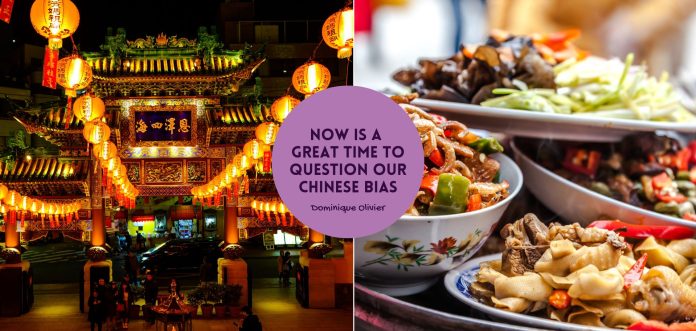A wave of TikToks from Chinese factory owners is reshaping how we think about where the things we buy come from. By casually revealing that many brandnamed products are made in Chinese factories, these videos are forcing a reckoning with a deeper bias: our enduring discomfort with the words “Made in China”.
There’s a curious influx of videos making the rounds on TikTok. In them, Chinese factory owners hold up luxury handbags, shoes, or athleisure wear and casually mention the brand they’re made for. Lululemon. First Ascent. Under Armour. Sometimes the logos haven’t even been added yet. Other times, the products are fully finished, just awaiting a flight to Paris, Milan, or Los Angeles.
Even when it comes to brands that you would reasonably expect to be made in China, like Nike, videos like these still rack up engagement:
@sm.elov Who are the Chinese suppliers for Nike?#sourcing #business #supplier #importing ♬ original sound – Skin care factory
For a certain corner of the internet, these videos have hit like a slap. They expose something we’ve all sort of known but deliberately ignored: that “Made in China” and big-name brands are not mutually exclusive. In fact, they often overlap.
Which brings us to the question: why do we have such a negative association with goods that are manufactured in China, even in the cases where the quality of the products are on par with those that are produced locally or elsewhere? We can make arguments about everything from the need to protect local manufacturing to the environmental impacts of globalisation – and all of those arguments are valid. But to have a truly well-rounded conversation, we need to acknowledge that there may be an element of anti-Chinese bias at play.
A uniquely Chinese headache
Monosodium glutamate (MSG) has had a rough PR run. On paper, it sounds pretty tame – it’s just the sodium salt of glutamic acid, which is a naturally occurring amino acid found in foods like tomatoes, mushrooms, and parmesan cheese. Toss it into a pot of stew or a meat broth and suddenly everything tastes a little deeper, a little richer, a little more oomph. In the flavour world, that oomph has a name: umami.
Back in 1908, Japanese chemist Kikunae Ikeda decided that the flavour of kombu (a type of seaweed used in dashi broth) was simply too delicious to leave unexplained. So he went to work to extract the magic molecule behind the savoury sensation, and called it monosodium glutamate. He even patented the process. By 1909, the Suzuki brothers were selling it commercially through a jointly-owned patent deal under the now-famous name Ajinomoto, which roughly translates to “the essence of taste”.
In the early days, MSG was marketed with a sleek sense of sophistication. The fine white powder was sold in slim glass bottles aimed squarely at the science-loving, hygiene-obsessed bourgeois housewife. In China, it was a hit with Buddhists, many of whom were vegetarian but still wanted their food to taste like something. MSG offered a way to dial up flavour without adding meat to the dish. In no time at all, MSG became a staple of Chinese cooking.
By the 1950s, MSG had quietly slipped into Western food supply. You could find it in everything from snacks and canned soups to frozen dinners and even baby food. It was everywhere and no one seemed to mind. Until they did.
In 1968, a doctor wrote a letter to the New England Journal of Medicine after a trip to a Chinese restaurant left him with arm tingles, fatigue, and a fluttery heart. He wasn’t sure what caused it – maybe the MSG, maybe the salt, maybe the cooking wine. But the seed of suspicion was planted. Readers flooded the journal with similar tales of post-dumpling malaise, and “Chinese Restaurant Syndrome” was born.
Researchers jumped on the trend and started churning out studies linking MSG to everything from headaches to brain fog. Newspapers fanned the flames: “Chinese Food Make You Crazy? MSG is No. 1 Suspect”, screamed the Chicago Tribune. Pop-science books with ominous titles like Excitotoxins: The Taste That Kills didn’t help. Suddenly, a molecule that had been quietly enhancing umami since the early 20th century was cast as a culinary villain.
The problem was that those early studies were riddled with flaws. Most notably, participants knew when they were consuming MSG, which (scientifically speaking) breaks the whole point of a blind trial. Later, more rigorous research found that when people weren’t told they were eating MSG, most didn’t react at all. Even self-proclaimed MSG-sensitive folks were fine unless they thought they were eating it.
So why did the panic persist? Well, part of it has to do with the deeply racialised framing of Asian food in the West. MSG became shorthand for “unnatural,” “dirty,” or “foreign”. To expose the xenophobic roots of this fear, you only have to consider that there is no “Pringles Syndrome” or “Hot Dog Syndrome”, despite the fact that both of these things contain as much MSG as the local Chinese restaurant’s Lo Mein.
From the late ’60s through the early ’80s, “Chinese Restaurant Syndrome” was treated as legitimate medical concern. It was the gluten intolerance of its day, except backed less by science and more by racial biases. Yes, a very small group of people may legitimately react to glutamate, but those cases are rare and not exclusive to Chinese food. Meanwhile, the FDA has kept MSG on its “generally recognised as safe” list this entire time.
And yet, public perception hasn’t kept up. Why? Because our brains love a neat narrative. If you once felt woozy after Chinese takeout and someone told you MSG was to blame, that’s the explanation that sticks. It’s what psychologists call the availability heuristic: we grab onto the most obvious answer instead of digging deeper. Once that belief is locked in, new info just kind of bounces off.
This is how we ended up with a world where Doritos are fine, but dumplings are suspect. I think the late superstar chef Anthony Bourdain said it best in a 2016 interview: “You know what causes Chinese Restaurant Syndrome? Racism.”
Luxe-for-less
If MSG was the canary, then the mine is the West’s ongoing discomfort with the idea that China could be both a producer of quality and a source of cultural legitimacy. This isn’t just about food; it’s about a broader, deeply ingrained narrative: things made in China are cheap, fake, or suspicious – unless, of course, a Western logo has been stitched on top.
Here’s where things get awkward.
For years, “Made in China” was Western shorthand for cheap and low-quality goods, but that reputation has often lagged behind reality. Today, China’s manufacturing sector is one of the most advanced globally, with factories operating at a scale and precision that many Western producers struggle to match. In 2023, China’s manufacturing industry generated $4.8 trillion in value added, making up 27% of the country’s total economic output. By contrast, the US, which was once the undisputed global manufacturing powerhouse, saw manufacturing contribute just over 10% to its economy in the same year.
From aerospace components to iPhones to high-end fashion, Chinese OEMs (original equipment manufacturers) are not only technically capable but often indispensable to the global supply chain (as a handful of American politicians are about to find out).
This capacity for excellence is not lost on luxury and aspirational brands. Companies like Prada, Nike, and even Hermès have tapped Chinese factories (sometimes quietly, sometimes overtly) to produce or source parts of their collections. Hermès, for example, launched the Shang Xia brand as a way to fuse Chinese artisanal traditions with luxury positioning, signaling a strategic move to embrace Chinese design without diluting its French heritage.
Despite this, Western suspicion toward Chinese-made goods continues to smuggle in old colonial assumptions: that Asian products are inherently suspect, or that anything made outside of Europe is counterfeit until proven otherwise. The panic over MSG in Chinese food is mirrored in the continued handwringing over the authenticity of luxury goods emerging from Chinese supply chains, even when those chains are contracted by Western brands themselves.
A story with many sides
And yet, this is not a simple story of Western ignorance. Some of the discomfort is not unfounded. China’s manufacturing prowess has often been built on the backs of poorly paid labour, long hours, and minimal regulatory oversight. In certain sectors, worker exploitation, unsafe factory conditions, and egregious environmental degradation remain ongoing issues. These are not problems unique to China, but their scale there (and the opacity of many factory operations) makes them harder to ignore.
So, we are left in a bind. China appears to be both the villain and the hero in the global manufacturing narrative. It’s a place where extraordinary craftsmanship coexists with troubling labour practices and where cutting-edge innovation operates alongside environmental shortcuts. To say that Western distrust of Chinese manufacturing is entirely racist or misplaced is too simple. But to pretend it is purely about ethics, and not also tinged with historical bias, is equally dishonest.
The truth is uncomfortably layered, much like those supply chains we’ve spent decades pretending are simple. As Chinese cars fill South African roads and cause chaos for legacy European brands, perhaps this bias is finally starting to disappear.
About the author: Dominique Olivier

Dominique Olivier is the founder of human.writer, where she uses her love of storytelling and ideation to help brands solve problems.
She is a weekly columnist in Ghost Mail and collaborates with The Finance Ghost on Ghost Mail Weekender, a Sunday publication designed to help you be more interesting. She now also writes a regular column for Daily Maverick.
Dominique can be reached on LinkedIn here.





Interestingly enough, the stark increase in quality of Chinese-made goods in the past decade relates to a national strategic plan which was formally signed in 2015. This industrial policy was termed Made in China 2025 which aimed to shift the industrial base from labor-intensive to technology-driven with the resultant output being of higher quality while remaining competitively priced. BYD’s battery technology surpassing Tesla’s comes to mind as a recent example. Closer to home, as you mentioned, one doesn’t have to look much further than the number of Havals on South African roads to give a good indication of the value-for-money proposition the cars provide.
That’s a fascinating insight – thanks for sharing it Craig!
Great article!
I think this is history repeating itself. Have a look at the “Made in Japan” and “Made in Germany” labels (or even “Made in Taiwan”, to a lesser extent).
After the Second World War, Japan was devastated but quickly rebuilt itself into a manufacturing powerhouse. The products they exported during the 50’s and 60’s were considered cheap, inferior and shoddy knockoffs, but by the ’70s brands like Sony, Honda, Yamaha and Toyota turned that perception around. Today “Made in Japan” is considered a mark of quality.
Let’s turn the clock back even further… The “Made in Germany” label was actually introduced by British legislation in 1887 to stem the tide of cheap and inferior products from Germany that were simply fake ripoffs of renowned British products. The label was meant to identify these fakes 😂 Today “Made in Germany” is considered a mark of quality.
First you imitate and then you innovate. It’s a very effective strategy, along with “fake it until you make it” 😁
The availability heuristic is such a strong force. I consider myself an open minded, rational individual, but sheeesh – I have not been successful in fighting that one. Its force probably also stems from the kick that you get from learning “crucial” fact on a new topic which you feel elevates you to the gnostics.
Anyways, always enjoy your pieces. Keep it up Dominique!